International Day in Support of Victims of Torture
Every year on 26 June, the United Nations observes the International Day in Support of Victims of Torture to highlight torture’s profoundly damaging and distressing consequences and its lasting generational impacts, serving as a reminder that torture is a deliberate and calculated infliction of severe physical and mental suffering that cannot be justified in any manner or form.
The UN Convention Against Torture and Other Cruel, Inhuman or Degrading Treatment or Punishment recognises that torture is perpetrated with the intent to extract confessions, punish dissenters, instil fear or perpetuate discrimination, within or without the compliance of those in positions of authority.
In recognition of the urgent need to eliminate torture and ensure the effective implementation of the Convention, the United Nations General Assembly, through resolution 52/149 on 12 December 1997, designated 26 June as the United Nations International Day in Support of Victims of Torture.
On this occasion, we urge governments and citizens across the free world, including human rights organisations and independent agencies, to exert pressure on China to eliminate the practice of torture in all its forms. Having ratified the Convention in 1998, China must fulfil its obligations as a state party to the Convention.
In 2022, TCHRD received information about the severe torture of a senior Tibetan monk in May 2013, part of China’s systematic practice to crack down on self-immolation protests, which began in 2009 and peaked in 2012 when 90 Tibetans self-immolated within a year to protest Chinese repression in Tibet. Severe beatings and torture were inflicted upon Tseta, a disciplinarian (Tib: ghe-gheu) at the local Adril monastery for merely capturing and disseminating a photograph of Sherab, a 33 years old Tibetan nomad who died of self-immolation in May 2013 in Chumarleb (Ch: Qumalai) County, Kyegu (Ch: Yushu) Tibetan Autonomous Prefecture, in the Tibetan province of Kham.
Although information about Tseta emerged late, it attests to the fact that Chinese authorities have employed torture as a tool to suppress freedom of expression and assembly in a widespread and systematic manner. After the brutal crackdown on the 2008 Tibetan uprising and the subsequent ongoing manhunt to trace and track down the protesters, Tibetans have increasingly resorted to self-immolations as a form of political protest against Chinese policies. Crackdowns on self-immolation were brutal and expansive, affecting not just individual self-immolators but also their family and relatives.
Likewise, the details of Dorje Tashi’s torture testimony, which became known only in 2021, provided further evidence that he was subjected to, sleep deprivation, poor diets, beatings with electric batons, prolonged stress positions, threats to harm his aged mother, and denial of medical care for four months all in an attempt to implicate him for non-existent political crimes.
The torture cases of Tseta and Tashi are not isolated incidents but examples of the various purposes for which Chinese authorities practice torture. It further demonstrates the institutionalisation of torture as a routine law enforcement and state security practices.
Needless to say, the continuous and persistent reliance on torture methods undermines the fundamental tenets of the Convention. Hence, it is of utmost importance for the international community to call for an immediate cessation of all acts of torture against Tibetans in Tibet.


